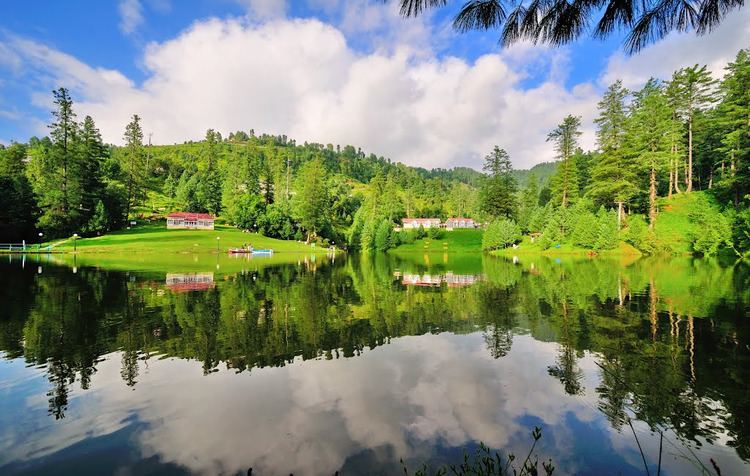 | ||
'Banjosa (Urdu: بنجوسہ)' is a small village and tourist attraction point about 20 kilometres (12 mi) from Rawalakot, Azad Kashmir. Word Banjosa is still undefined but according to local peoples, Banjosa is hindko words, consist of two parts "Bun" means forest and Jousa was resident of the area. Banjosa has three main Marketplaces, (Mareed Na Bagla), R.A bazar, Miral Gala and Gale wala pir Bazaar. Religious militancy or freedom fight in Kashmir was launched by Captain Hussein khan and Other Pakistani Militants from Banjosa valley and other parts of Kashmir . This area is famous for its beautiful lake know as Banjosa Lake and sometime it also refers as Chotagala lake.
Contents
- Map of Banjosa Lake
- Introduction
- History
- Religion
- Education
- Culture
- Politics
- Transportation
- Economy
- Minerals
- References
Map of Banjosa Lake
Introduction
Banjosa is a beautiful village located in Tehsil Rawalakot, Poonch, Kashmir. This village is famous for its beautiful lake. Before unlawful occupation of Kashmir by India and Pakistan, considerable minorities were present in Banjosa valley. Literacy rate of Banjosa is almost 80%. Banjosa is further officially divided into belts like Challa, Mareed e na Bagla, Kotore, Danna, etc.
History
In the beginning, Banjosa was tenanted by Kashmiri Hindu Pindiths. Muslims were alien in Banjosa around late 13th century. According to few Natives, Sudhans in Banjosa are combination of Saduzai and Kashmiri Barhamans. However, According to religious scholar of Banjosa Sardar Muhammad Azam Khan, Sudhans are immigrants of Palangi, Kashmir. After a long span of time, delineated clans of Mugals and Kiyanis were undertake in Banjosa.
Religion
Today, 99.9% of the population of Banjosa is Muslim. 98% population of Banjosa is sunni Muslim and 1% is Shia Muslim and trace amount of Ahmadiyah Muslims, Atheists, Multi-religious followers are also present.
Education
Master Nandi Lal a Hindu teacher was a person who established first educational institute in Banjosa. He was very noble person and respected by peoples of Banjosa. He was considered as a great person who educate peoples of Banjosa. Educational institutes are present in Banjosa such as Govt women Degree College and School, Tafheem-ul-olum high school for boys, Kashmir Public School, Islamic Public School, Ideal Public School, Banjosa Public school, Branch of Pir Alou din University and Banjosa valley Boarding school.
Culture
An influence of Pakistani culture is strongly present in Banjosa. Shalwar Kameez is commonly wear dress locally. Significant majority also wears western clothes. Western culture is also dominating in women`s fashion locally. Pahari Language is spoken by native peoples.
Politics
Theocratic politics is present in peoples of Banjosa. However, concept of Free Kashmir is supported by 97% Banjosees. Significant strength of socialism is also present.
Transportation
Van system is present in this area without any alteration for last 20 years. However, due to rapid growth personal vehicles are used by 99% Banjosees. Kashmir main Highway is passed from center of Banjosa.
Economy
Economy of Banjosa is mainly based on foreign Exchange, Self business, and civil services etc. Approximately 11% peoples are serving in Pakistani Military, 23% peoples are working in abroad, 9% working in civil services and approx. 2% works in Bureaucracy of Azad Kashmir. Contribution in economy of Banjosa by women is very high in ratio as compare to any rural part of Pakistan.
Minerals
Iron ores, bauxite deposits, graphite deposits, gypsum deposits are found nearby Challa to Chabber along ford, magnesium, evidence of limonite deposit is abundantly found along Ford bank. Evidence of coal and marble deposits are also found nearby Chotagala road. Limestone is abundantly present in Banjosa.
